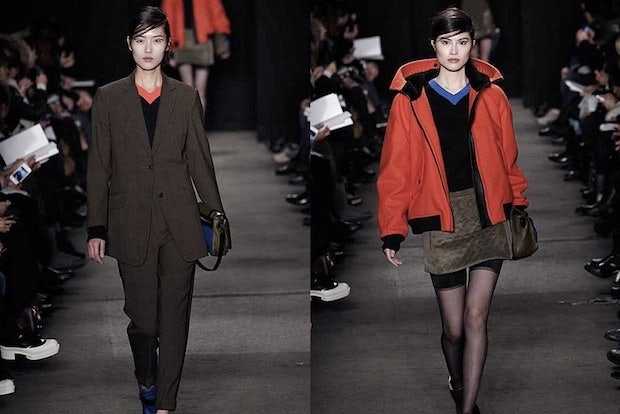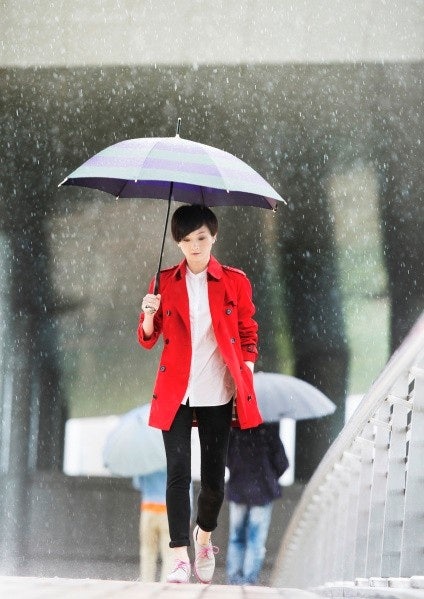
Chinese models Liu Wen (L) and Sui He (R) on the runway at Rag & Bone's Fall 2013 show.
Just as many in the West are finally returning to productivity after a long holiday season, China’s business community—and the overall economy—is preparing to shut down for the most important holiday of the year: the lunar new year.
During Chinese New Year, China pretty much closes down for the better part of a month, and most Chinese workers return home to families, enjoy banquet meals, and celebrate the New Year with traditions such as cracking fireworks, noshing dumplings, giving red envelopes, and watching the interminable Chinese New Year gala extravaganza on China Central Television (CCTV).
As China continues to modernize and amass striking concentrations of wealth, both the social structure of families and the way people celebrate the New Year are beginning to shift.
The 40-day period surrounding the Chinese New Year (often called Chunyun 春运) encompasses the largest human migration in the history of the world, and it repeats every year. Within China, the total number of Chunyun journeys exceeds three billion, including more than 35 million trips by air. Many of China’s wealthiest travelers, eschewing the annual chaos of this infrastructure-straining mass exodus, will plan international holidays during Chinese New Year, either on package tours to Thailand, Korea, and other popular Asian destinations, or to North America and Europe. Others simply stay put with their families and celebrate seasonal traditions.
Given the importance of luxury goods within Chinese social structures, gifting patterns, and consumption patterns, luxury now plays a significant role in Chinese New Year as popular gifts and new trends emerge. The luxury industry is acutely aware of this fact and releases limited-edition products, shopping experiences, and promotions during this crucial sales period, both in China and via overseas retailers.
To get a better sense of how individual Chinese are planning to spend the New Year in 2014, China Luxury Advisors spoke with a selection of Chinese consumers:
- A 43 year-old financial researcher in Xinjiang plans to celebrate Chinese New Year with a new tradition of taking his family skiing. They will go shopping at local malls and search for his most coveted luxury products: shoes by Bally and an iPhone from Apple, Inc.
- A 23 year-old banker in Beijing aims to stay home with family this New Year with no plans to go out or shop. She mainly hopes to receive money for Chinese New Year and the brand she is most interested in right now is Kate Spade.
- A 51 year-old teacher in Beijing plans to travel during the New Year. She plans to go outlet shopping and buy La Mer skincare products, and is hoping for a big red envelope full of money for the New Year.
- A 23 year-old Chinese student studying in Los Angeles will be celebrating the New Year with friends in Los Angeles, where she will be shopping at boutiques and online for Rag & Bone jeans and a classic Burberry trench. She is hoping to receive skincare products as gifts for Chinese New Year.
- A 22 year-old logistics manager in Beijing will celebrate the holiday with friends and family in Beijing. He is wishing for an Admiral watch from Longines.

Burberry's trench has proven popular with Chinese consumers in the era of no-logo luxury. (Burberry)
Notice the relative lack of showy luxury references in this sample? While the focus of Chinese New Year continues to be in gifting as demonstrations of respect, a mantle of subtlety has descended on the prestige sector.
With the continuing crackdown on corruption and the resulting reduction in luxury sales growth on the mainland, the luxury industry within China will undoubtedly not see the extravagance that Chinese New Year once brought, with lavish banquets featuring showy gifts of logoed watches and handbags.
However, watch for continued spending in the luxury sector on subtle, logo-free products and luxury shopping and experiences overseas, away from the crowds of China’s Chunyun travelers and the ever-snooping eyes of China’s netizens.
Just in time for Chinese New Year, China Luxury Advisors and Jing Daily will be hosting a webinar on Weibo vs. WeChat on January 15. Register here.
Sage Brennan is co-founder of China Luxury Advisors, a boutique consultancy that helps luxury brands and retailers to develop China-related strategies, ranging from market entry to social media to attracting, converting, and retaining Chinese tourists. Sage first visited China in 1987, and has worked in China as a researcher, investor, entrepreneur, journalist, and advisor, with a specialization in digital, mobile, and strategy. Follow China Luxury Advisors on Facebook or Twitter.